Exploring Bright Direct Light in Interior Design
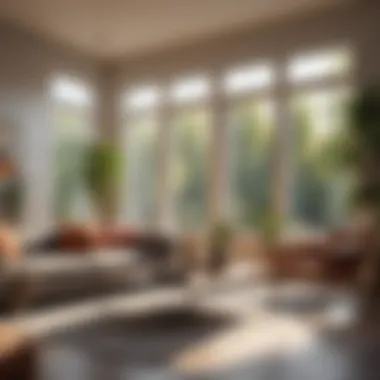
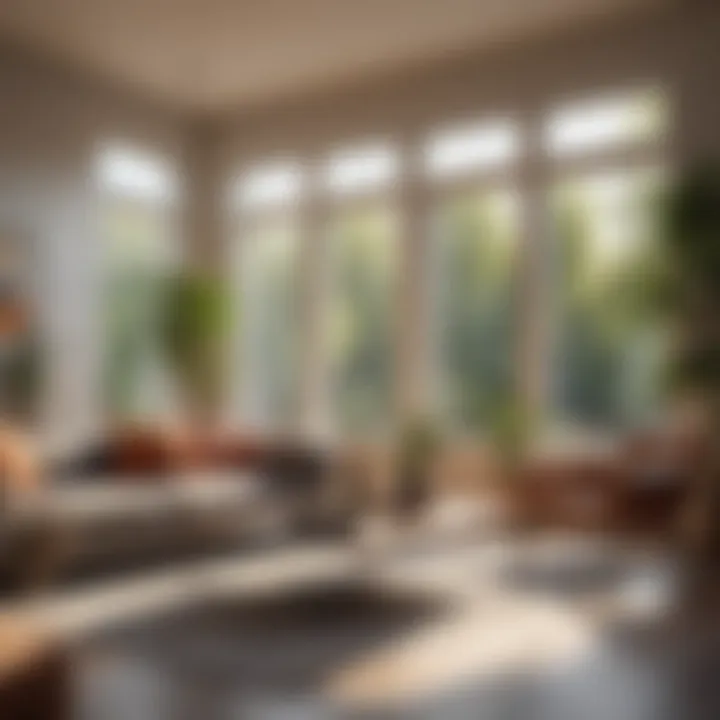
Intro
Bright direct light holds a significant place in the world of interior design, not merely as a source of illumination but as a powerful tool that shapes the very atmosphere of a space. It influences how spaces are perceived and, more intriguingly, how they feel to those who inhabit them. Envision walking into a room flooded with sunlight that invigorates your mood, energizes your body, and somehow makes even the simplest decor sparkle. This influence is both subtle and profound.
Understanding bright direct light's role can seem like threading a needle in a haystack. Whether it’s the way light dances off a well-placed mirror or illuminates a carefully curated art piece, this dynamic quality of light contributes vastly to the mood and overall vibe of a space. Interior design enthusiasts often find themselves grappling with how to best harness this light, maximizing its benefits while minimizing any potential drawbacks it might introduce, like glare or harsh shadows.
In the following sections, we will navigate through various aspects, including how current trends in design utilize light, delve into color palettes that thrive in bright environments, and offer practical tips for maintaining a nuanced approach to interior lighting. This exploration aims to equip homeowners, party hosts, and gardening aficionados with the knowledge they need to effectively integrate bright direct light into their spaces. By understanding these dynamics, you can create environments that not only look good but also feel right.
Understanding Bright Direct Light
Bright direct light plays a pivotal role in shaping how we experience and interact with interior spaces. Its dynamics are not merely about illumination but encompass broader aspects such as mood enhancement, functionality, and design aesthetics. Understanding this type of light is crucial for homeowners and interior design enthusiasts aiming to create spaces that resonate with their needs.
The essence of bright direct light lies in its ability to punctuate dimensions and maintain vibrancy. Utilizing it strategically can help maximize spatial perceptions, making rooms feel more open and inviting. For instance, a well-lit living room with large windows can transform a dull space into a sunny haven, boosting not just ambiance but also the psychological well-being of its occupants. This light can elevate colors, making them pop and thereby influencing how we perceive the overall atmosphere.
Moreover, it encompasses essential benefits. It can be instrumental for activities that require clarity, such as reading or crafting, where bright, focused light is paramount. Without understanding bright direct light's role, one might unintentionally create areas that feel closed off and dark.
Significantly, when one understands these dynamics, they can also become more conscious of the limitations and challenges associated with bright direct light. It’s not all roses; glare and overexposure can lead to discomfort or distractions. Thus, a nuanced understanding is needed to harness its potential effectively.
"Light is the most important element in design; it brings visible results to the invisible."
Definition and Characteristics
Bright direct light is characterized by its intensity and clarity. Typically associated with sunlight that enters a space through windows, this type of light casts sharp shadows and defines edges vividly.
In terms of measurement, the brightness of light is indicated in lumens, a unit quantifying the total amount of visible light emitted by a source. Understanding the lumens necessary for particular activities lets homeowners tailor their lighting approach to suit their lifestyle needs. For instance, a workspace may require a higher lumen count than a cozy reading corner.
Characteristics include:
- Intensity: This type of light illuminates surfaces more directly than diffused light, which can soften shadows and create a more muted effect.
- Clarity: Bright direct light enhances color and texture, serving to bring out details in interior design elements.
- Contrast: This light creates contrasts that can dramatically transform how spaces feel. A room bathed in bright light can feel energizing and lively, while the same space in low light may feel intimate or even somber.
Natural versus Artificial Light
There’s a fine line distinguishing natural light from artificial light, yet both hold their unique places in illuminating interior spaces.
Natural Light: This light is derived from sources like the sun and varies throughout the day. It brings warmth and changes in hue that artificial lighting often can’t replicate. A sunlit room thrives during the day; sunrise invites soft golden hues while the afternoon rays can create a vibrant atmosphere.
Artificial Light: This encompasses every man-made source of illumination, such as incandescent, LED, and fluorescent lights. While advancements have greatly improved the aesthetic quality of artificial lighting, it often lacks the dynamic nature of natural light. However, strategic use of artificial lighting can mimic daylight to some degree, compensating during darker hours.
The Psychological Effects of Light
Bright direct light plays a significant role in shaping our internal environments, influencing not just our perceptions of space but also our emotional responses and cognitive functions. The importance of this topic lies in understanding how various light qualities can drive moods, evoke emotions, and even improve productivity. Creating an environment that utilizes light effectively can result in spaces that feel more alive and inviting, thus enhancing the overall experience for homeowners and guests alike.
Influence on Mood and Emotion
Light can be a subtle yet powerful influencer of our moods. Bright direct light, particularly when harnessed correctly, can brighten not just a room but also the spirits of those within it. The relationship between light and mood isn’t just anecdotal; it’s backed by studies showing that exposure to bright white light can uplift someone's emotional state.
For example, consider a large living room with generous windows that allow sunlight to bathe the space during the day. The natural sunlight can create feelings of warmth and happiness, often more intense during the golden hours of the morning and late afternoon. In contrast, harsh or stark lighting can foster feelings of anxiety or discomfort. This subjectivity in response emphasizes the need for thoughtful implementation of light dynamics in interior spaces.
Moreover, the time of day plays a critical role. Natural light changes throughout the day, offering different hues that can affect our psychological state. For instance, morning light can invigorate while evening light can calm. Homeowners can thus use these principles to enhance the design of their space according to activity levels throughout the day, creating a dynamic atmosphere that resonates with its occupants.
Cognitive Function and Productivity
Beyond merely affecting emotions, bright direct light can significantly enhance cognitive function and productivity. An environment well-lit with bright light can stimulate mental alertness, enhance focus, and ultimately boost overall performance.
Research indicates that people working in brightly lit spaces often perform tasks faster and with increased accuracy as compared to those in dimly lit areas. A well-illuminated workspace, perhaps with a large skylight or expansive windows, can facilitate better decision-making processes and enhance creative output. This is why design considerations around workspaces have increasingly adopted principles that favor light—opt for white or light-colored walls to reflect sunlight, integrate screens that minimize glare, and select ergonomically designed furniture that complements the space without overshadowing its illumination.
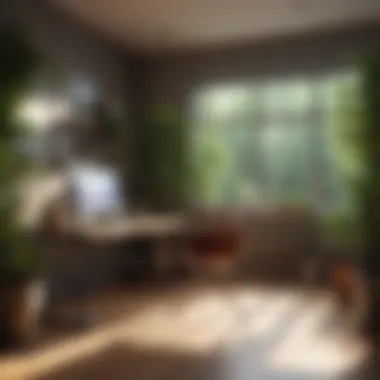
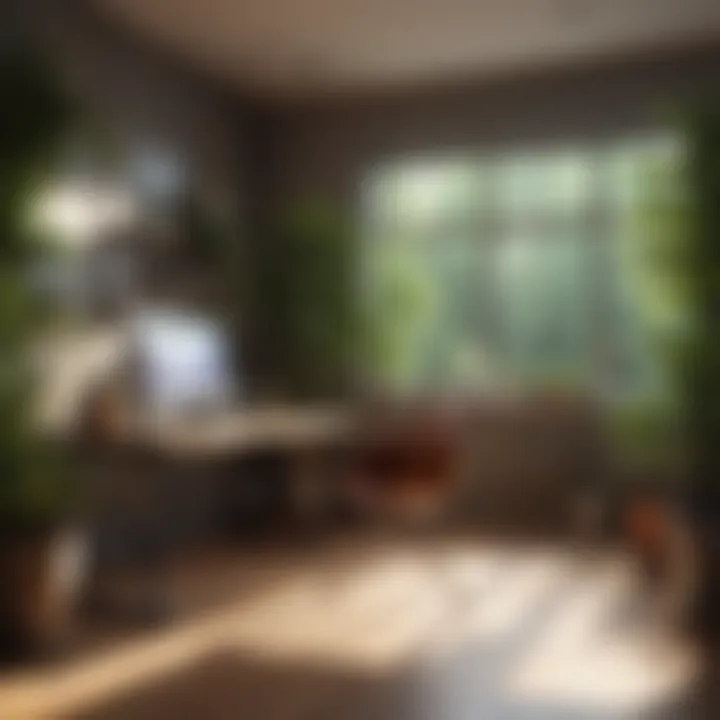
"Light is not just a utility; it is a crucial component of human experience, influencing everything from feelings to functions."
In moving forward, integrating bright direct light into interior designs holds significant promise for transforming spaces into realms of productivity and positivity. Homeowners, interior design enthusiasts, and party hosts alike can harness this understanding, ensuring that each space reflects the vibrance and energy that direct light has to offer. Doing so creates not just more beautiful interiors, but also spaces that enhance the quality of life for all who inhabit them.
Design Principles for Bright Direct Light
When venturing into the realm of interior design, the mastery of light is undeniably paramount. Bright direct light serves not only to brighten a space but also to sculpt its very character. This section unveils the principles that guide the incorporation of such light, highlighting its profound influence on ambiance, functionality, and aesthetics in any given environment.
Maximizing Natural Light in Interior Spaces
To start, employing natural light is like bringing a slice of the outside world into one's home. By strategically positioning windows and using glass doors, designers can create an environment that speaks volumes. It’s akin to opening the curtains wide on a beautiful morning; the transformation is immediate. Consider the use of skylights to flood hallways or small rooms with sunlight, or oversized windows that allow the outside scenery to serve as a shifting work of art on your walls.
Additionally, the layout of furniture plays a significant role. Placing furniture away from windows and opting for lighter colors can create an inviting atmosphere that feels spacious and airy. The presence of greenery, too, can enhance natural light; plants reflect light, further illuminating their surroundings, much like setting a vase of fresh-cut flowers on a sun-kissed counter.
Adopting an open floor plan can also maximize light flow across spaces. By eliminating unnecessary walls, light can traverse the areas freely, making a home not just brighter, but welcoming.
The Role of Reflective Surfaces
Reflective surfaces act as allies in the quest for brightness. Just picture a well-placed mirror across from a window; it’s like having a second set of windows right there! Mirrors and shiny surfaces amplify brightness by bouncing natural light around, creating an illusion of space and openness that’s simply delightful.
Using high-gloss finishes on furniture or walls can also play a part in how light behaves in a room. These reflective elements can transform the atmosphere, taking dull corners and injecting life into them. Think of the chic appeal of a glossy white kitchen? It's more than just aesthetics; it’s about maximizing every ray of sunlight.
- Considerations for reflective surfaces:
- Placement: Position mirrors and shiny surfaces strategically to optimize light reflection.
- Materials: Choose materials that enhance brightness, such as glass, polished metals, or light-colored tiles.
Layering Light: Balancing Brightness and Softness
Finally, layering light envelops a space in warmth and comfort. Bright light doesn’t need to overpower; instead, it can coexist with softer elements to create a balanced ambiance. Using a combination of different light sources ensures that no corner is left lurking in shadow.
Incorporating warm-toned fixtures alongside bright daylight can soften the intensity without diminishing the cheerful vibes of direct lighting. Floor lamps, wall sconces, and recessed lights can complement the natural exposure, adjusting the mood depending on the time of day or activity. It’s similar to how a comfortable throw blanket can enhance a chilly evening – it adds coziness without overshadowing the environment’s essence.
Create clusters of lights at varying heights to draw the eye and encourage movement throughout the space.
"Light is not just a necessity; it shapes the very experience of living in a space."
Technical Considerations in Light Design
Designing with bright direct light involves critical technical aspects that can impact the effectiveness and experience of a space. Knowing how light works is as essential as selecting the right color palette or furniture. It allows designers to harness light to enhance not just the look of a space but its feel and functionality.
Lighting Fixtures and Their Impact
When thinking about bright direct light, lighting fixtures play a monumental role. Choosing the right fixture is like finding the perfect frame for an artwork. Different types of lighting fixtures, from pendants to recessed lights, can dramatically alter how light behaves within a space. A sleek LED pendant can offer an elegant touch while providing a focused beam that highlights specific areas. Meanwhile, wall-mounted lights can cast warm washes of brightness, bringing a softer ambiance even amidst the harshest daylight.
Consider the following factors when selecting lighting fixtures:
- Type of bulb: LED, incandescent, or fluorescent - each offers distinct characteristics regarding intensity, warmth, and energy use.
- Adjustability: Some fixtures offer dimming capabilities, allowing users to tailor the brightness to their needs quickly.
- Material and finish: The surface of a fixture can influence light diffusion and reflection. A polished chrome fixture might enhance brightness, while a matte finish can soften it.
Incorporating a variety of lighting fixtures in a cohesive design brings versatility and can contribute to a deeper emotional connection to the space.
Color Rendering and Brightness
Light’s ability to reveal colors is paramount in interior design. Color rendering refers to how accurately a light source displays colors compared to natural light. This is measured by the Color Rendering Index (CRI), a score from 0 to 100, where higher indicates better performance. The higher the CRI, the more true-to-life the colors appear. In spaces where aesthetics are crucial, like galleries or showrooms, using lights with a high CRI is essential.
Bright direct light, when combined with the right color rendering, can transform ordinary spaces into vibrant showcases, highlighting textures and drawing attention to the intricacies of design features such as artwork or furniture upholstery.
Additionally, brightness, quantified in lumens, dictates how well a space can be illuminated. For example, a living room may need about 1,500 to 3,000 lumens for pleasant brightness, while a workspace may require closer to 5,000 lumens. Striking a balance between general illumination, task lighting, and accent lighting ensures that no corner is left in the shadows.


Sustainable Lighting Solutions
In today's eco-conscious world, incorporating sustainable lighting solutions is not merely a trend but a responsibility. Modern advances in technology have made energy-efficient lighting more accessible and varied.
Consider these sustainable options:
- LED Lighting: These consume significantly less energy compared to traditional bulbs while providing bright, direct light conducive to various tasks.
- Solar-Powered Fixtures: For those looking to bring natural light dynamics indoors, solar-powered lamps with good brightness can be a suitable alternative, especially for outdoor spaces.
- Smart Lighting Systems: Integrating smart bulbs allows users to adjust brightness and color temperature based on time of day or activity, which can reduce electricity consumption.
By adopting sustainable lighting practices, you not only reduce your carbon footprint but also create a healthier atmosphere that resonates with a growing audience that values environmental awareness.
The Aesthetic Function of Bright Direct Light
In the realm of interior design, bright direct light plays a pivotal role in shaping the aesthetics of a space. It goes beyond mere functionality; it is a powerful tool for enhancing visual appeal and creating an atmosphere that can transform ordinary environments into extraordinary experiences. By leveraging bright light, designers can not only illuminate a space but also highlight its most striking features, thus creating an inviting and dynamic environment for inhabitants and visitors alike.
One key element of utilizing bright direct light effectively is its ability to accentuate textures and patterns present in the materials used throughout a space. This increases depth and intrigue, drawing the eye to unique details that might otherwise go unnoticed. On the flip side, this very brightness can cast shadows, giving spaces a dramatic flair that adds character and interest; hence, interior designers need to carefully plan how light interacts with these aspects.
The benefits are manifold, as bright light can:
- Enhance Color Perception: Bright light shifts how colors are perceived, making them look more vibrant and lively, which can help in choosing the right palettes for different moods.
- Create Spatial Dimension: Effective use of lighting can manipulate how we view space, creating an illusion of roominess or coziness depending on the design intent.
- Focus Attention: Bright light can guide the observer's gaze to focal points within the room, whether it be a stunning piece of art or intricate architectural details.
Successful integration of bright direct light into interior design is not without its considerations. Designers must account for potential glare and the psychological impacts such light can induce on inhabitants. With this balance, bright direct light can achieve a harmonious aesthetic that delights the senses.
Highlighting Textures and Patterns
Texture and pattern are often the unsung heroes of interior design, quietly influencing a space's character. Bright direct light plays a significant role in unveiling these elements, allowing them to shine in all their glory. For instance, when sunlight streams through a window onto a textured wall, it can create mesmerizing visual dynamics. The angles of light enhance the surface irregularities—every bump, dip, and ridge becomes more pronounced, adding life to an otherwise flat surface.
Each material responds differently under bright direct light. Ceramics might radiate warmth, textiles could display intricate patterns, while metals will reflect light in dazzling ways. Understanding how these materials interact with illumination is crucial. As such, designers often choose materials that complement their lighting strategies. Consider the elegance of a rough-hewn stone wall bathed in sunlight—the play of light and shadow can be nothing short of breathtaking.
- Natural Materials: Timber, stone, and cotton exhibit textures that are enhanced by bright light. This combination can transport a space into a realm of raw sophistication.
- Patterned Fabrics: Upholstery and curtains that feature bold graphics can really pop. Bright light brings clarity to intricate designs, enriching the overall décor.
By emphasizing textures and patterns through bright lighting, designers enrich the tactile experience of a space, making it more engaging and visually stimulating.
Creating Dramatic Shadows
Shadows are often perceived negatively in lighting discussions, but bright direct light can leverage them to create a sense of drama and intrigue. Shadows can transform an interior, adding layers of complexity and dimension. The interplay between light and shadow can accentuate architectural elements, soften harsh lines, and guide the flow of movement through a space.
Dramatic shadows can also evoke emotional responses. For instance, high-contrast lighting can create a theater-like atmosphere in a living area, instilling a sense of sophistication. Spaces that favor natural light, such as large open areas with tall windows, can generate theatrical shadows that morph throughout the day, shifting the feel of the room as the sun progresses across the sky.
To harness shadows effectively, here are a few strategies designers can employ:
- Layering Light Sources: Using different types of light fixtures in conjunction with bright direct light allows for controlled shadow formations.
- Choosing the Right Angles: Positioning light sources at various angles will elongate or shorten shadows, allowing for versatility in design aesthetics.
- Intentional Design Elements: Using materials that naturally create shadows, such as sculptures or intricate grilles, can enhance the overall look of a space.
"A well-placed beam of light is often the most persuasive way to express beauty. Shadows in the right measure can tell stories that words cannot convey."
In summary, the aesthetic function of bright direct light is crucial for highlighting textures and patterns and creating compelling shadows. Its effectiveness relies on the ways designers manipulate it to evoke feelings, enhance details, and shape environments, offering homeowners remarkable, immersive experiences in their own spaces.
Challenges of Bright Direct Light
Bright direct light can transform a space, but it doesn't come without its share of challenges. Understanding these obstacles is crucial for homeowners and interior design enthusiasts who want to create a comfortable and inviting environment. The most pressing issues include glare, overexposure, and the subsequent fade of colors. Recognizing these challenges allows for informed decisions when planning lighting schemes and selecting materials in interior design.
Glare and Its Mitigation
Glare occurs when intense light causes discomfort, making it difficult to see properly. It can be particularly problematic in spaces where people work, study, or engage in activities requiring focus. Imagine sitting at your desk when the afternoon sun blasts through the window; your screen becomes unreadable, and your eyes strain. Not only is this distracting, but it can also lead to headaches and fatigue over time.
To tackle glare, consider the following strategies:

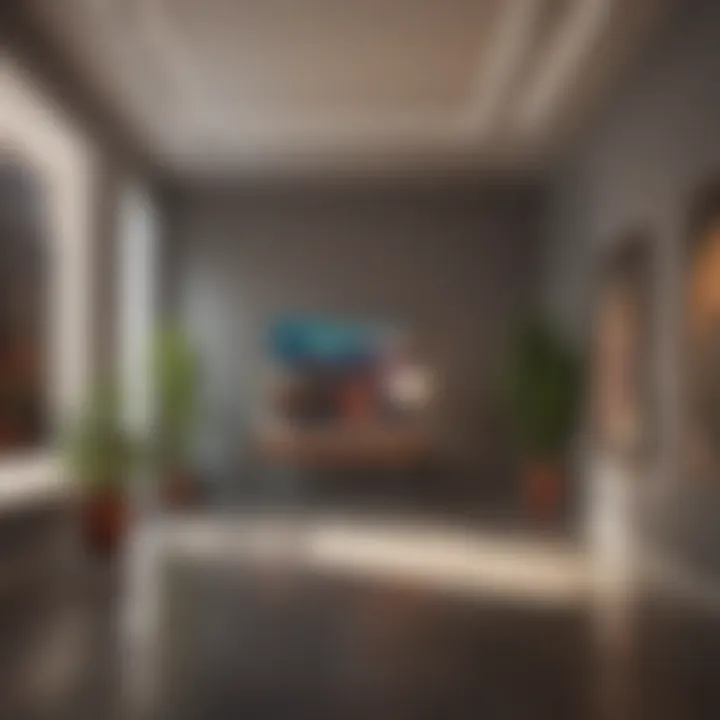
- Use window treatments: Drapes, shades, or blinds can help diffuse the light, softening its intensity while maintaining visibility.
- Add awnings or pergolas: Outside structures can block direct sunlight before it reaches the window, thus minimizing glare inside.
- Choose lighting fixtures wisely: Fixtures that direct light downward, like recessed lights, help focus illumination and reduce reflections.
- Position furniture with care: Arranging desks or seating away from direct light sources can prevent discomfort while still keeping the space bright.
"Mitigating glare isn’t about dimming your spaces but finding the balance between light and comfort."
Overexposure and Color Fading
Overexposure to bright direct light can have a detrimental effect on colors and materials. Fabrics can become bleached, and artworks may lose their vibrancy, significantly impacting the overall aesthetic of a room. This fading is particularly concerning for homeowners who invest in statement pieces, such as designer upholstery or dynamic wall art.
To prevent overexposure and its effects, homeowners can:
- Select UV-protective window films: These can block harmful rays while still allowing natural light to filter through. It's an effective way to combat the fading of colors without sacrificing brightness.
- Rotate items periodically: If you have art or fabrics that are prone to fading, moving them to less exposed areas from time to time can help prolong their life.
- Opt for light-resistant materials: Choosing textiles or finishes that are specifically treated for UV resistance can extend the lifespan of your décor.
- Create shaded areas: Incorporating plants, furniture, or architectural features can help diffuse harsh sunlight that would otherwise lead to overexposure.
By acknowledging these challenges, homeowners can become proactive in their approach to bright direct light. This understanding not only elevates interior aesthetics but also nurtures a comfortable and functional living environment.
User Experience and Bright Direct Light
When considering bright direct light in interior spaces, it’s crucial to look beyond mere aesthetics. User experience plays a significant role in how inhabitants engage with their environment. After all, a space might look beautiful, but if it’s not comfortable or functional, the sweet allure of design can quickly wear thin. Bright direct light affects how we feel and interact with our surroundings. Its impacts can range from elevating mood to creating spaces that are practical for varied daily tasks.
Designing for Comfort and Accessibility
Comfort is the name of the game in any thoughtful design. Bright direct light has the potential to enhance comfort but can also do the opposite if not managed correctly. When we talk about accessibility, we consider how well a space can be used by individuals of all ages and abilities. For instance, too much glare can make reading or working difficult—and for those who struggle with sight issues, this can be a real barrier.
- Dimming Options: It’s beneficial to incorporate dimmer switches or smart lighting systems, giving inhabitants control over light intensity. A gentle touch of brightness can often change the mood without becoming overpowering.
- Layered Lighting: Combine bright direct light with softer ambient lighting. This balance helps to create a cozy atmosphere, allowing for both focused tasks and relaxation.
- Choosing the Right Fixtures: Consider fixtures that can diffuse harsh light. Some LEDs have adjustable warmth, allowing you to tailor the environment to specific tasks throughout the day.
- Orientation and Positioning: How light enters a space can impact comfort significantly. Positioning furniture to avoid direct sun glare while maximizing natural light creates a haven that feels welcoming.
Ultimately, the goal is to turn a house into a home where everyone feels they can thrive.
Adapting Spaces for Various Activities
Every household has a distinct rhythm, with activities ranging from quiet reading to lively gatherings. Bright direct light must accommodate these varying needs. Designers and homeowners alike should consider how spaces can adapt for different uses throughout the day.
- Flexible Design: Consider using moveable partitions or furniture that can easily be reconfigured. This adaptability can help in achieving proper light levels for each specific activity, be it yoga in the morning sun or a family dinner in the evening.
- Task-Specific Lighting: In areas where detailed tasks are performed, such as kitchens or workspaces, ensure bright light sources are well-placed. Under-cabinet lighting can help illuminate countertops effectively while keeping the space inviting.
- Variability of Activities: Children’s play areas might need brighter light for creative activities, while a reading nook could benefit from a softer hue. Strategies for adapting these spaces is invaluable in maintaining a vibrant yet comfortable environment.
- The Role of Textures: Utilize materials that reflect light differently. For instance, a soft rug can break harsh reflections in family rooms, countering the brilliance of bright light.
By fostering a user experience that respects comfort and versatility, bright direct light can truly enhance the livability of indoor spaces.
"The proper use of light not only shapes a space but also transforms how we experience and feel about that space every day."
In summary, integrating bright direct light into interior design must be purposeful. It's not just one size fits all. An effective approach requires understanding individual needs while keeping the overall functionality of spaces in mind.
Future Trends in Lighting Design
Smart Lighting Technologies
Today, smart lighting technologies are at the forefront of interior design, offering homeowners the ability to personalize their spaces in ways that were once unimaginable. These systems employ a variety of features that adapt lighting based on time, activity, and even individual preferences. For instance, imagine coming home after a long day and having your living room gradually illuminated to your desired setting as you approach. This creates a welcoming atmosphere, utilizing bright direct light effectively.
With smart lighting, control is a key theme:
- Remote Management: Users can control lighting from their smartphones or tablets, adjusting brightness and tone from across the room or even while away from home.
- Automated Scheduling: Certain systems allow for programmed settings that can mimic natural light rhythms, promoting well-being and productivity.
- Compatibility with Other Technologies: Integration with home automation systems can enhance the user experience, allowing for coordinated lighting with heating and electronics.
Moreover, these technologies often use energy-efficient LED options, which not only reduce utility bills but also decrease the carbon footprint of homes. As trends move toward sustainability, the integration of smart technologies into lighting design is inevitable.
Biophilic Design and Natural Light
Biophilic design is another significant trend that intertwines our built environments with the essence of nature. This concept taps into our intrinsic affinity for the natural world by incorporating elements like natural light, greenery, and organic materials. Bright direct light plays a critical role in this approach, bringing outdoor vitality indoors.
Key aspects of biophilic design include:
- Maximizing Natural Light Availability: Whether through large windows or innovative skylight designs, ensuring that interior spaces benefit from the sun's bright light helps in creating a connection with the outside environment.
- Usage of Plants and Greenery: The inclusion of plants in areas flooded with natural light not only beautifies a space but also improves air quality and psychological well-being.
- Natural Colors and Materials: Using earthy tones and textures can further enhance the feeling of being in nature, facilitating a calming effect on the inhabitants.
Substantial research supports the benefits of biophilic design, which consistently shows improvements in productivity and overall happiness for those who dwell in such environments. In a day and age where many of us find ourselves absorbed in a digital world, blending these natural elements with bright direct light offers an antidote.
"Designs that mirror nature can encourage relaxation and focus, fostering a healthier relationship between individuals and the spaces they inhabit."
As we steer towards a more interconnected future, the trends in smart lighting and biophilic design are set to redefine the dynamics of bright direct light in our interiors, making spaces not just livable, but truly vibrant.















